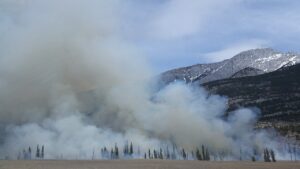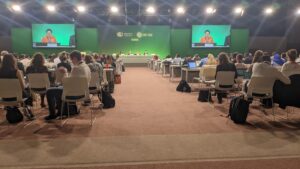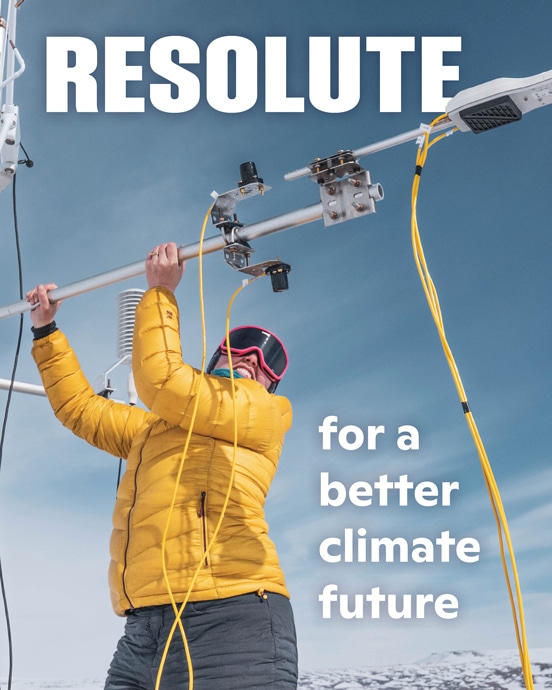Weather whiplash, wildfire smoke, and flooding rains — a look back at the extreme weather of 2023
It’s been a wild ride, with weather extremes that had us running the Shop-Vac in our basements, seeking refuge from unhealthy air, and scratching our heads at a cold snap in the midst of a mild winter. Climate experts say there’s more to come.

The past year has been marked by extreme weather across New England — punctuated by an extreme Arctic blast, followed by relentless rains that even now aren’t letting up.
Scientists say many of these events track with what’s expected with a warming — and already warmer — planet.
The mid-December storm, which inundated the East Coast under as much as 7 inches of rain and battered it with high winds, seems to be yet another bullet point in this relentlessly rainy year, which also has the distinction of being Earth’s hottest year in recorded history.
Read more on The Boston Globe.
Yes, the climate crisis is now ‘gobsmacking.’ But so is some progress
This is the year that “absolutely gobsmackingly bananas” summed up the climate emergency. But dramatic descriptors extend to the huge gains humanity has made too.

Scientists are running low on words to adequately describe the world’s climate chaos. The National Oceanic and Atmospheric Administration could already say earlier this month that there was more than a 99 percent chance that 2023 was the hottest year on record. That followed September’s sky-high temperatures—an average of 0.5 degrees Celsius above the previous record—which one climate scientist called “absolutely gobsmackingly bananas.” When one of this summer’s rapidly intensifying hurricanes, fueled by extraordinarily high ocean temperatures, leapt from a 60-knot tropical storm to a 140-knot Category 5, one scientist simply tweeted: “Wait, what???”
1. Collaborating with Communities
This year, Woodwell Climate’s Just Access Initiative went global. Just Access works in close partnership with communities to provide tailored, actionable climate risk reports for Rio Branco, Brazil; Addis Ababa, Ethiopia; Summit County, Utah; and Lawrence, MA. At COP28, Just Access released their latest report in collaboration with the Ministry of Environment and Sustainable Development of the DRC, which focused on climate risks and potential solutions in the country and identified carbon markets as a potential funding mechanism for adaptation efforts.
Just Access collaborates with local officials and advocates to ensure the final reports cover information critical to their community’s planning. So far, 14 reports have been completed and more are on the way.
Read the report.
2. Tongass National Forest Protection
In January of 2023, the Biden Administration restored protections against logging and road-building for more than 9 million acres of the Tongass National Forest, the world’s largest intact temperate rainforest.
This came after Woodwell Climate’s Dr. Wayne Walker and Geospatial Analyst Seth Gorelik, along with long-time collaborator Dr. Dominick DellaSalla of Wild Heritage, delivered a research report to the Biden administration showing massive carbon stores in Tongass National Forest and highlighting the importance of roadless areas.
3. Citizen Science with Science on the Fly
In 2023, Science on the Fly’s (SOTF) focused their activities on stewarding their community of scientists. Together they collected more than 3,000 water samples from hundreds of locations around the globe. SOTF leverages the passion and dedication of the global fly fishing community to gather data on the health of rivers across the world. With this data, SOTF can improve our understanding of how watersheds and river systems change over time due to climate change and local effects.
Read about the project’s activities this year.
4. Training the Next Generation of Researchers
We sent 10 Polaris Project students into the field this summer. The Polaris Project engages the brightest young minds from a diversity of backgrounds to tackle global climate research in one of Earth’s most vulnerable environments: the Arctic.
Students conducted their own research projects over two weeks at a field research station near Bethel, Alaska. Afterwards, they returned to the Center to analyze samples, and presented their findings at the American Geophysical Union meeting in December.
Woodwell Climate also hosted several interns through the Partnership Education Program. These undergraduate students participated in research and communications activities across the center.
Read PEP intern, Jonathan Kopeliovich’s story about research in Howland Forest.
5. Convening Critical Conversations
Woodwell Climate has been conducting tropical forest research in Brazil for nearly two decades alongside partner organization IPAM Amazônia. This year, Water Program Director, Dr. Marcia Macedo and collaborators, including Dr. Ane Alencar of IPAM, convened a multi-day workshop in Brazil that produced a policy brief on forest degradation. They then organized experts to submit public comments on Brazil’s updated policy for controlling Amazon deforestation, which for the first time also addresses forest degradation.
Read the policy brief here.
Across the globe, Permafrost Pathways partner, Alaska Institute for Justice (AIJ), hosted a “Rights, Resilience, and Community-Led Adaptation” workshop on Dena’ina homelands in Anchorage, Alaska. The two-day workshop created space for Tribes to share their expertise with each other and connect face-to-face with federal and state government representatives to access resources and technical assistance.
Read more about the workshop.
6. Representing Our Expertise
Our experts showed up as thought leaders this year at several high profile events. As just a few examples, Woodwell Climate’s Arctic Program Director Dr. Sue Natali and Senior Science Policy Advisor Peter Frumhoff both spoke on panels alongside other leading voices in climate at SxSW in Austin, TX. Senior Geospatial Analyst, Greg Fiske attended the Esri User Conference, where his topographic map of Alaska garnered two awards. And Assistant Scientist, Dr. Ludmilla Rattis gave a talk at TED Countdown about her research on the role of Tapirs in rainforest restoration. (Recording coming in early 2024)
7. Making Headlines
Woodwell Climate team members showed up in over 5,000 media stories this year. Our scientific leadership provided quotes for a broad range of high profile climate stories in New York Times, Reuters, Boston Globe, CNN and Grist, just to name a few. Senior Scientist Dr. Jen Francis was quoted over 4.2K times, appearing in major news outlets like the Washington Post and AP News to provide accessible context about the links between climate change and extreme weather events.
8. Rebuilding an Arctic Research Station
Last fall, Scotty Creek Research Station in Canada—one of the only Indigenous-led climate research stations in the world—was almost entirely consumed by a late-season wildfire. Woodwell Climate’s Permafrost Pathways project is providing rebuilding support to the Łı́ı́dlı̨ı̨ Kų́ę́ First Nation. Project scientists Dr. Kyle Arndt and Marco Montemayor visited the site for two weeks this spring to restore an essential carbon monitoring tower.
Read the story of Scotty Creek.
9. Advancing the Scientific Literature
Our researchers published 80 peer-reviewed scientific publications this year. From the Arctic to the Tropics, from soil concentrations to river concentrations, Woodwell Climate had a part in discovery.
Recent trends in the chemistry of major northern rivers signal widespread Arctic change
Grain-cropping suitability for evaluating the agricultural land use change in Brazil
Explore all our publications.
10. Leading on the World Stage
Woodwell Climate’s President & CEO Dr. Max Holmes brought Woodwell Climate to the main stage of CERAWeek, Green Accelerator Davos, GenZero Climate Summit in Singapore, Climate Week NYC, and Mountainfilm Festival. He discussed cutting-edge climate science alongside notable figures like Bill McKibben and former Colombian President Iván Duque Márquez.Read about Dr. Holmes’ time at Davos.
Here’s how experts graded US climate progress in 2023
Climate experts give the U.S. mixed grades on its efforts to mitigate climate change — but they all agree there’s room for improvement.

’Tis the season to be merry … and get graded. As students across the country anxiously await their report cards, we thought it would be a good time to ask climate experts to grade the United States’ efforts to address the issue over the last year.
They were more than happy to play along.
Longleaf pine restoration—a major climate effort in the south—curbs its ambitions to meet harsh realities

A public-private partnership confronts the challenges of nature-based solutions, including urban growth, logging pressures and a warming planet
On a fall walk through Tuskegee National Forest, ecologist John Kush kept his eyes on the ground, looking for sprouts of hope.
“It’s not too bad,” he said, cautiously. “The overstory is longleaf. But it’s the understory that tells the picture.”
A retired Auburn University research fellow, Kush has spent much of his life studying Pinus palustris—the longleaf pine. The state tree of Alabama, it once reigned throughout the southeastern United States, but was all but given up for dead not long ago. Beginning with European settlement, and accelerating after the Civil War, logging and resin extraction drove the sturdy, long-needled species to near-extinction. Less than 3 percent of its original 92 million acre range remained by the 1990s.
Continue reading on Inside Climate News.
COP 28, the annual meeting of United Nations delegates to set goals and report progress on addressing climate change, closed last week in Dubai after a two-week rollercoaster that was both promising and discouraging. When weak draft language surfaced, just a few days before negotiations were set to close, shying away from any clear call to eliminate fossil fuels, the outlook was not optimistic. But nearly overnight, representatives managed to arrive at a deal. For the first time in 28 years of negotiations, the final agreement included direct reference to the need to “transition away from fossil fuels in energy systems, in a just, orderly, and equitable manner.”
The language is not as strong as many hoped, but it still represents a historic step forward, and came as a positive surprise after controversy surrounding the oil interests of the host country.
“We’ve known from COP number one that fossil fuels are a major cause of the problem with respect to climate change, but the reality is that it wasn’t until COP28 that the words ‘fossil fuels’ were actually recognized in the agreement,” says Woodwell Climate CEO and President, Dr. Max Holmes. “It’s really late in the game, but I think it’s important that this was finally recognized. Yet words are not actions, and much more needs to be done.”
International agreements were also made to reduce methane emissions generated by fossil fuel extraction and triple renewable energy by 2030, as well as enact the agreed-upon Loss and Damage fund created last year, which will use contributions from wealthier countries to support those suffering the worst climate-related impacts.
Progress also occurred on many smaller stages at COP28. Woodwell Climate had a strong presence, sending 16 scientists and staff to advocate on a variety of issues, including increased ambition in curbing emissions, funding for adaptation measures, action around permafrost and tropical forest issues, and improvements in transparency around carbon markets. Here are some of our key highlights and takeaways from COP28.
Protecting tropical forests
One core tenet of the Center’s research is the value of protecting and restoring natural ecosystems for both their intrinsic and climate importance. A check-in on pledges to end deforestation by 2030 shows they are mostly going unmet, but the final agreement did include language that acknowledged the importance of “protecting, conserving, and restoring forests”, which Woodwell Carbon Program Director, Dr. Wayne Walker, notes was another significant inclusion this year.
“Nature has a tremendous role to play and that’s really what this section is trying to emphasize: the importance of bringing nature to bear in the mitigation conversation alongside transitioning away from fossil fuels,” said Dr. Walker.
Woodwell Climate used this year’s COP to build and deepen partnerships that advance efforts to protect the carbon-storage powerhouses that are tropical forests. For example, Woodwell Climate hosted a discussion with Health in Harmony and Pawanka Fund about the power of investing in Indigenous-led climate solutions.
“Woodwell has been partnering increasingly with organizations like Health in Harmony and Pawanka fund, who are really strong advocates of Indigenous self-determination”, says Dr. Walker. “Pawanka Fund is a really great example of an Indigenous-led fund that provides direct support to Indigenous initiatives focused on promoting and protecting traditional knowledge, well-being, rights, and self-determined solutions to a whole host of issues. Organizations like [them] are critical to properly compensating Indigenous peoples for their contributions to climate change mitigation.”
Climate risk and carbon markets
On December 5, Woodwell Climate announced the release of a new report in partnership with the Ministry of the Environment and Sustainable Development (MEDD) of the Democratic Republic of Congo (DRC). The report was the culmination of a multi-year collaboration to generate a localized, customized, cost-free climate risk assessment for the country that details both challenges and solutions.
“This report was two years in the making, and was only possible because of close collaboration between Woodwell scientists, government leaders in the DRC, and experts at the University of Kinshasa,” says Woodwell Chief of Government Relations. “Our goal was to provide an actionable risk assessment that could directly inform Congolese policymaking. We developed that, but our partnership also identified the need for increased scientific and technical capacity, as well as a new framework for carbon market regulation.”
The assessment identified improved carbon credit integrity as a mechanism to fund climate adaptation projects in the DRC and support forest preservation as a critical natural climate solution.
“We and others think carbon markets will have tremendous potential for bringing large amounts of capital to the ground to the people into the places responsible for implementing natural climate solutions,” says Dr. Walker. “But there’s no question that right now, carbon markets are plagued with all sorts of problems. There’s a lot of work to be done if they’re to function properly, sustainably, equitably.”
Pushing for permafrost accountability
Unfortunately, neither the Arctic nor permafrost were mentioned in the COP28 final agreement and Woodwell Climate Arctic Program Director, Dr. Sue Natali, says it is crucial that changes.
“Permafrost emissions can consume about 20% of our remaining carbon budget to avoid 1.5 C, and there will be much greater emissions from permafrost if we overshoot 1.5 C,” says Dr. Natali.
Dr. Natali spoke at several events in the Woodwell Climate space as well as in the Cryosphere Pavilion during Permafrost Day. Top of mind was not only the need to incorporate permafrost emissions into global carbon budgets, but also the need for Loss and Damage funding to extend to Northern communities being displaced by thawing and eroding permafrost. Discussions around Loss and Damage funding are currently focused on supporting countries in the global south, but many Arctic communities are grappling with decisions about relocation and adaptation, and have been for decades.
“These communities who already have very limited land are losing it to permafrost thaw, wildfire, increased storm impacts. This has been going on for a really long time and they urgently need resources,” Dr. Natali said.
Where the rubber meets the road
“These high-minded Nationally Determined Commitments are ambitious in their target setting, but the national level policy is where they become reality,” says McGlinchey. Emphasizing that we will have to wait and see how the promises made at this year’s COP are enacted by different nations. During the conference, the Woodwell Climate meeting space was visited by two US senators, Ed Markey of Massachusetts and Lisa Murkowski of Alaska, who showed interest in permafrost and other climate issues.
Looking towards COP29, which will be hosted in Azerbaijan, the hope is that ambition and national commitments will increase, because while progress was made in this year’s agreement, it was nowhere near big enough to limit warming to below 1.5 degrees celsius. With current warming at around 1.2 degrees, we will have to be swift and decisive.
“This past year was a remarkable one— the hottest on record. The impacts of climate change are here and are being felt by people here and around the world. And that adds urgency,” says Dr. Holmes.
For the full debrief of COP28, you can watch our Webinar here.
Woodwell Climate’s Dr. Sue Natali appointed to DOI adaptation science council
Woodwell Climate’s Arctic Program Senior Scientist and Permafrost Pathways Lead Dr. Sue Natali was appointed by U.S. Secretary of the Interior Deb Haaland as a member of the new federal Advisory Council for Climate Adaptation Science.
Read more on Permafrost Pathways’ website.
Making Sense of COP28

Insights and reflections from members of Woodwell Climate’s delegation to the 2023 UN Climate Change Conference.




